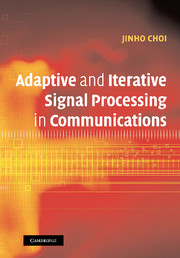Book contents
- Frontmatter
- Contents
- List of figures
- List of tables
- Preface
- List of symbols
- List of abbreviations
- 1 Introduction
- I ISI channels and adaptive signal processing
- II Iterative signal processing for ISI channels
- 5 MAP detection and iterative channel estimation
- 6 Iterative receivers over static ISI channels
- 7 Iterative receivers under time-varying channel conditions
- III Other interference-limited systems
- Appendix 1 Review of signal processing and the Ƶ-transform
- Appendix 2 Important properties of matrices and vectors
- Appendix 3 Background for probability and statistics
- References
- Index
7 - Iterative receivers under time-varying channel conditions
Published online by Cambridge University Press: 23 November 2009
- Frontmatter
- Contents
- List of figures
- List of tables
- Preface
- List of symbols
- List of abbreviations
- 1 Introduction
- I ISI channels and adaptive signal processing
- II Iterative signal processing for ISI channels
- 5 MAP detection and iterative channel estimation
- 6 Iterative receivers over static ISI channels
- 7 Iterative receivers under time-varying channel conditions
- III Other interference-limited systems
- Appendix 1 Review of signal processing and the Ƶ-transform
- Appendix 2 Important properties of matrices and vectors
- Appendix 3 Background for probability and statistics
- References
- Index
Summary
It was shown in Chapter 6 that the iterative receiver can provide an excellent performance through iterations with known CIR. In practice, the CIR should be estimated and the channel estimation error can degrade the performance of the receiver. Various approaches taken to design the iterative receiver with channel estimation can be considered. It is desirable that the channel estimation can be improved through iterations by taking advantage of the iterative processing (i.e., the availability of prior (or extrinsic) information from the channel decoder).
This chapter discusses iterative receiver design for unknown time-varying channels taking two fundamentally different approaches. The first approach is an extension of the iterative receiver with the MAP symbol detection studied in Chapter 6. To deal with unknown and time-varying channels, the MAP symbol detection is generalized to incorporate the channel estimation. Since a straightforward implementation requires high computational complexity, an approximation will be introduced.
The second approach is a channel estimation oriented approach. The main focus of this approach is to find the MAP estimate of a time-varying channel process rather than the MAP data symbols. The detection/decoding is carried out as part of the iterative channel estimation based on the EM algorithm. Some approximations will also be studied to reduce the complexity.
Detection/decoding for unknown time-varying channels
In this section, we will discuss two different approaches taken to perform the detection/decoding and channel estimation for unknown time-varying random channels. The first is the detection/decoding oriented approach. Suppose that b denotes a coded symbol vector (or sequence) that is transmitted over a time-varying ISI channel.
- Type
- Chapter
- Information
- Adaptive and Iterative Signal Processing in Communications , pp. 171 - 192Publisher: Cambridge University PressPrint publication year: 2006



